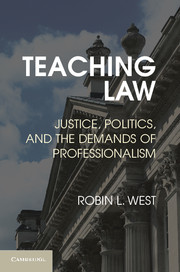Book contents
- Frontmatter
- Dedication
- Contents
- Acknowledgment
- Introduction The Trouble with Law Schools
- 1 The Unbearable Lightness of Justice
- 2 Politics and Its Discontents
- 3 The Bifurcated Academy: The Practice versus the Study of Law
- 4 Confronting Our Existential Challenge
- Some Conclusions
- Bibliography
- Index
- References
2 - Politics and Its Discontents
Published online by Cambridge University Press: 05 June 2014
- Frontmatter
- Dedication
- Contents
- Acknowledgment
- Introduction The Trouble with Law Schools
- 1 The Unbearable Lightness of Justice
- 2 Politics and Its Discontents
- 3 The Bifurcated Academy: The Practice versus the Study of Law
- 4 Confronting Our Existential Challenge
- Some Conclusions
- Bibliography
- Index
- References
Summary
Somehow, sometimes, the exercise of political will produces law. People in power – despots, kings, presidents, congressional majorities, legislative committees, superpacs, the wealthy, parliamentarians, senators, representatives or referenda voters – effectuate their will through law, and that law is then followed by others, begrudgingly or not, and sometimes even by the people that produced it. Law is also, commonly, the product of some sort of political process – a despot’s dictate, a state referenda, legislative maneuvering, interest group politics, committee procedure, passage of a bill by both houses followed by an executive’s signature, fiat.
Sometimes that entire process, from the stirring in the heart of the political animal somewhere in the body politic seeking to make a change, to passage and enforcement of an effective law, is entirely admirable, and honorable, even noble. We can think of plenty of examples from our own political history. A social problem afflicting the powerless or voiceless – homelessness, or domestic violence, or poor nutrition, or inadequate educational opportunities for special needs children – is noticed, and then addressed, by a coalition of advocacy groups. Those groups educate the public, who eventually bring it to the attention of legislators, who then, after fact finding and coalition building and bargaining, if need be, enact a law that seeks to ameliorate or even abolish the problem. The result is some legislative enactment – a program that provides housing vouchers for working class and poor people, or the Violence Against Women Act, or the Occupational Safety and Health Act, or the Individualized Disability Educational Act, or nutritional programs for mothers and children – all of which, although all imperfect, nevertheless aim to better the terms of our social welfare net, or more broadly, our social compact. That actually does happen sometimes: individuals, advocacy groups, and legislators are moved by sympathy with co-citizens who are in some measure of distress, and use law as a tool to ameliorate their plight. Sometimes, the process is quite different, but also with laudable ends: the existence of shared pain, or the sufferance of a common injustice, across a swath of the population mobilizes large groups of people who through a combination of civil actions, demonstrations, peaceful disobedience, and street theater manage to spark a social movement, which then cannot help but capture the attention of even thoroughly self-interested legislators; it is in their face, as we say.
- Type
- Chapter
- Information
- Teaching LawJustice, Politics, and the Demands of Professionalism, pp. 93 - 130Publisher: Cambridge University PressPrint publication year: 2013



